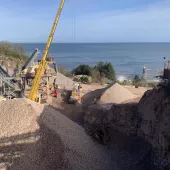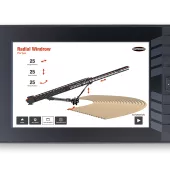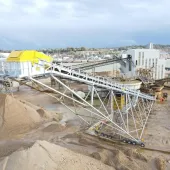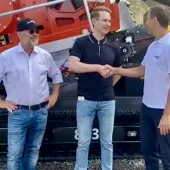Conveyor Belt Mechanical Splicing vs Vulcanizing
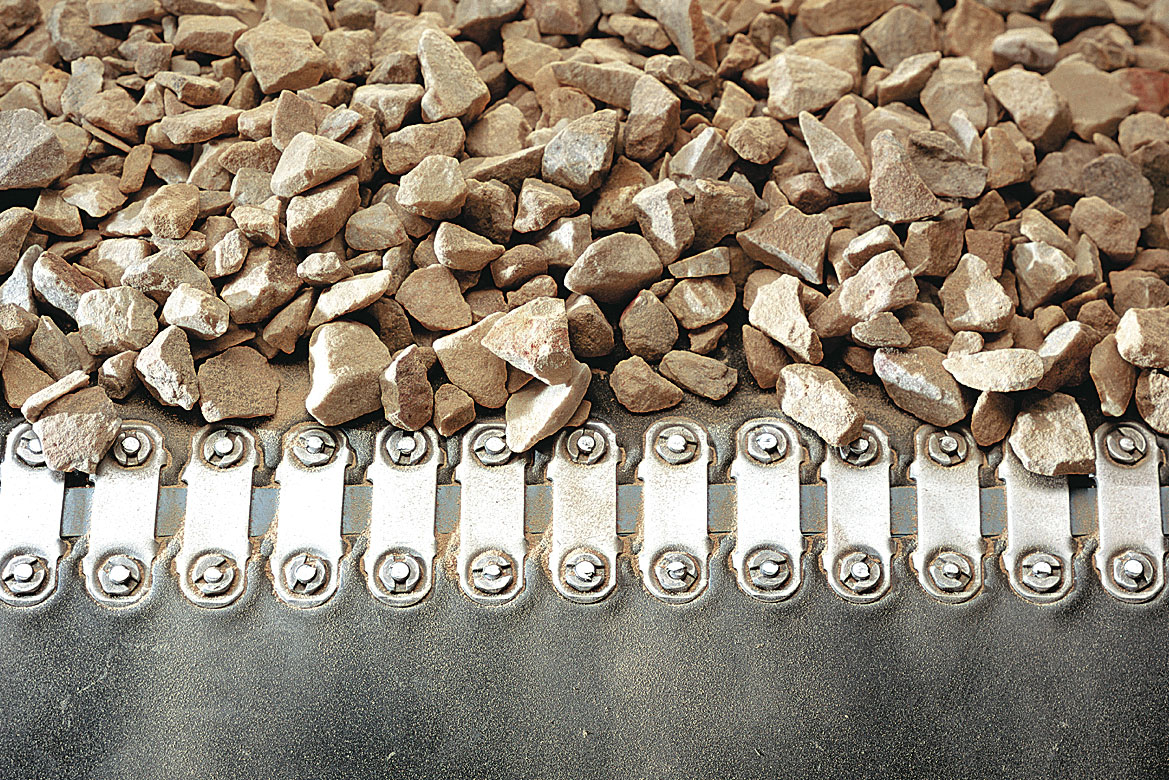
First published in the April 2018 issue of Quarry Management as Mechanical Splicing vs Vulcanizing
Which is better? Mark Colbourn compares the two main methods of conveyor belt splicing and highlights the benefits of mechanical fasteners in the search for increased productivity.
Conveyor systems are at the heart of most quarries and mines, and with extractive operations doing everything they can to improve operating efficiencies and reduce costs, they an excellent first checkpoint when seeking to optimize productivity. A critical area of importance on any conveyor system is the splice, and in most applications there are two preferred types of splicing method: mechanical splicing, which joins belt ends by metal hinges or plates; and vulcanized splicing, which joins belt ends through heat and/or chemicals.
Understanding the pros and cons of each method is extremely important when making an educated decision on which splicing method to use. What are the environmental factors that might affect the splice? Are workers up against time constraints? What are the costs associated with long conveyor downtimes? These are just some of the questions to ask when choosing between mechanical fastening and vulcanization.
Vulcanization process
Vulcanization is a complex procedure that, if done correctly by an expert, can offer a smooth splice with minimal risk of snagging, tearing and other harmful wear to the belt. There are several types of vulcanized splice, including stepped splices, finger splices and overlap splices, and two types of vulcanizing processes, hot and cold. Each process requires unique tools and an intimate knowledge of the rubber bonding process.
For both hot and cold vulcanization, the belt must be disassembled and each belt end prepared according to that particular belt’s splicing recommendation. Proper belt preparation is crucial to ensure the finished splice will hold to its published tensile ratings.
With hot vulcanization, splices are heated and cured under pressure with a vulcanizing press. This process takes several hours. If a belt is re-tensioned and used before the splice is bonded and completely cooled, the splice will be ineffective and may come apart completely, causing additional downtime.
Cold vulcanization does not employ a vulcanizing press, but instead uses a bonding agent that causes a chemical reaction to splice the two belt ends together.
When vulcanizing, several factors must be considered to ensure a high-quality splice. First, an expert who is skilled and trained in the procedure and who has a thorough knowledge of solvents, bonding materials and other cover and fill materials must perform a vulcanized splice.
Secondly, the process requires a specific temperature, compression and equipment dwell time, in addition to a virtually moisture-free work area.
Thirdly, some types of belt may not allow for vulcanization. If the belt is old, dirty or unevenly worn, vulcanization is not a good option because it will not always cure evenly, which can result in a weaker splice.
Vulcanized splicing of a 600mm wide belt could take between six and 11 hours, depending on working conditions. Wider belts may take longer. And because vulcanization often requires time for a specialized vulcanizing crew and equipment to be brought on site, operations can be shut down for half a day or more.
To summarize, vulcanized splicing can be used where:
- The belt is clean and free of contaminating agents, such as oil, sand and material fines
- The belt is compatible with the adhesive of choice
- The belt is new or without excessive wear
- The procedure is performed by a trusted, certified vulcanizer
- The work environment is at an optimal temperature and moisture level
- There is easy access to the area that needs splicing and plenty of room to work
- There is enough downtime available to allow for a properly installed vulcanized splice.
Mechanical fasteners
Mechanical splice installation is quick and simple. Depending on belt width and thickness, most mechanical splices can be finished in less than one hour and are installed by an in-house crew with portable, easy-to-use installation tools.
If an unexpected splice is required, it is not necessary to wait for professional assistance. In addition, mechanical splices can be made in restrictive environments with no special regard for space, temperature, moisture or contaminants.
Mechanical splicing also offers reduced belt waste and visibility of splice condition, both of which can significantly reduce costs. Because vulcanized splices often require the consumption of 2–3m of belt length, conveyors may not have enough ‘take-up’ if more than one splice is necessary over time.
Moreover, because a mechanical splice is visible, wear and deterioration is apparent and can be taken care of before a complete belt failure. Vulcanized splices, in contrast, typically deteriorate from the inside out due to poor adhesion. The first sign of wear comes too late for any preventative measure, resulting in longer downtime.
Mechanical splicing
As with vulcanization, there are several types of mechanical fastener, each created for use with different belt widths, lengths, thicknesses, speeds, tensions and belt cleaners.
Identifying the correct fastener for the application is essential to ensure maximum splice life and performance. Mechanical fasteners are available in two types – hinged and solid plate – and with a variety of attachment methods, including rivets, bolts and staples.
For extractive applications, rivet-hinged fasteners allow for the greatest versatility. They combine top and bottom fastener plates, which are joined at one end by two wide hinge loops. Each pair of plates sandwiches the belt end and is secured to the belt with a staggered pattern of rivets. The rivets penetrate the belt without damaging or weakening the belt carcass, because they slip between the load-bearing carcass fibres. The rivets are installed in a staggered pattern to provide maximum resistance to pull-out and to distribute splice tension evenly across the width of the belt.
No matter what the belt condition, mechanical fasteners are a good choice for both new and older, worn belts. Rivet-hinged fasteners can be used on belt thicknesses ranging from 3mm to 25mm with minimum pulley diameters of 230mm.
Concerns about comparable vulcanized splice strength can also be dismissed: rivet-hinged fasteners have a long history of service on belts, with mechanical fastener ratings of up to 350kN/m or 2,000 pounds per inch of width (PIW).
Because removing the hinge pin can easily separate hinged fasteners, these designs are essential in mining and quarrying applications where belts must frequently be removed, extended or shortened. In addition, hinged fasteners provide several installation benefits in these applications.
For example, the hinged fastening system permits separate halves of the belt to be pre-spliced, requiring only the hinge pin to be inserted at the job site. Also, if belts of different thicknesses must be joined, hinged fasteners can often satisfy this need by allowing two different fastener halves to be joined by a hinge pin acceptable to both. Moreover, mechanical fasteners can be installed quickly and easily, on-site, by in-house maintenance crews, usually in less than 60min.
Mechanical splice installation tools are easily transported to the job site and offer splice installers versatility in installation methods. Depending on the site’s available power source, mechanically attached rivet-hinged splices can be installed with as little as a basic installation tool and hammer, or with a modified installation tool and choice of electric or air-actuated power source.
Mechanical fasteners can also be countersunk during the installation process, so the fastener plates are flush with the belt’s cover, which eliminates interference with tight-fitting scrapers, skirt boards and other conveyor components. Countersinking also strengthens the fastener-to-belt attachment by positioning the plates closer to the belt’s load-bearing carcass fibres. The belt strength remains intact, as only a portion of the top cover material is removed, while the belt’s vital carcass fabric is left intact.
Besides virtually eliminating fastener rip-outs, rivet-hinged splicing cuts downtime by giving maintenance crews more freedom in deciding when to replace a splice. Any splice damage or wear and tear is very visible on a mechanical splice, and operators can finish a shift even with a few plates missing and not have to worry about belt failure.
Vulcanization vs Fastening – some common misconceptions
Every splicing method has its limitations, and it is essential to get the facts before deciding how best to splice a belt. Some of the most common misconceptions include:
‘Mechanical fasteners cannot be used with higher-tension belts’ (ie more than 800 PIW). Synthetic belts and improved fastener designs have resulted in mechanical fasteners that are compatible with belt tension ratings of up to 350kN/m (2,000 PIW).
‘With mechanical fasteners, sift-through of carried materials is a problem’. To prevent leakage and sift-through, vulcanized belts are ideal. However, when all things are considered, mechanical fastening may be preferable. If the splice is done properly, sift-through should not present a problem. Solid-plate splices can be sift-proof and, if filler materials are used with a hinged fastener, only minimal sifting should occur.
‘Mechanical fasteners are noisy, incompatible with belt cleaners and scrapers, and generally damaging to the belt’. If mechanical splices are properly installed, maintained and countersunk by skiving the belt, there should be no problem with noise or damage to the belt or belt cleaners.
‘All belts can be vulcanized’. Old and/or worn fabric belts are not well suited to vulcanization because the belt layers are weaker and will become brittle when heat is applied. Older rubber belts are also poor candidates for vulcanizing, as the bondable properties of rubber deteriorate over time. Finally, vulcanizing requires additional belt length, so operations with little take-up simply may not have enough belt to vulcanize.
‘You can vulcanize any time, anywhere’. Only clean, dry and relatively warm conditions are suitable for vulcanizing. Chemical residues, excessive moisture and extreme temperatures can interfere with the curing of adhesives and cause nicks and/or bubbles. These conditions, in turn, weaken the strength of the splice. In addition, vulcanizing can be extremely difficult in areas that are not easily accessible.
‘Vulcanization does not mean a lot of downtime’. Vulcanization actually requires the shutdown of the belt for a substantial amount of time – much longer than a mechanical splice would require. Not only do the chemicals take several hours to cure, but a vulcanized splice is also at the mercy of the vulcanizer’s schedule.
‘Vulcanization does not compromise belt strength’. Vulcanizing actually robs the belt of an entire ply of strength – even more if not done properly. Mechanical fastening, on the other hand, does not compromise the belt’s integrity.
‘Inspecting a vulcanized splice is easy’. The early signs of adhesion breakdown in a vulcanized splice are nearly invisible to the naked eye. Often, operators are not even aware that a vulcanized splice is experiencing problems until it fails – a catastrophic event that requires the immediate shutdown of the line.
Fact of life
Conveyor belt and belt splice damage will always be a fact of life in most bulk material handling applications. Consequently, operations and maintenance personnel should have a thorough understanding of the available splicing and repair alternatives, and how each method can affect the productivity and cost-effectiveness of operations.
New designs, materials and processes are making mechanical splicing better, and incorporating mechanical belt fasteners into a splicing routine can provide numerous benefits for output and bottom line. In most applications, mechanical splices offer the flexibility, economy and speed needed to minimize material and labour costs, and avoid expensive downtime situations.
About the author
Mark Colbourn is the managing director of Flexco Australia. This article first appeared in Quarry magazine, the official journal of the Institute of Quarrying Australia, and is reproduced here by kind permission.
- Subscribe to Quarry Management, the monthly journal for the mineral products industry, to read articles before they appear on Agg-Net.com



